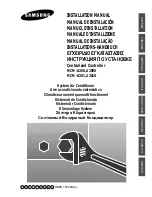
Refrigerant
Piping
Connection
6.
Place flaring tool onto the form.
7.
Turn the handle of the flaring tool clockwise
until the pipe is fully flared.
8.
Remove the flaring tool and flare form, then
inspect the end of the pipe for cracks and
even flaring.
Step 4: Connect pipes
When connecting refrigerant pipes, be careful
not to use excessive torque or to deform the
piping in any way. You should first connect the
low-pressure pipe, then the high-pressure pipe.
MINIMUM BEND RADIUS
When bending connective refrigerant piping,
the minimum bending radius is 10cm.
≥10cm (4in)
Radius
Instructions for Connecting Piping to
Indoor Unit
1.
Align the center of the two pipes that you will
connect.
Indoor unit tubing
Flare nut
Pipe
Max.
Step 2: Remove burrs
Burrs can affect the air-tight seal of refrigerant
piping connection. They must be completely
removed.
1.
Hold the pipe at a downward angle to prevent
burrs from falling into the pipe.
2.
Using a reamer or deburring tool, remove all
burrs from the cut section of the pipe.
Pipe
Reamer
Point down
Step 3: Flare pipe ends
Proper flaring is essential to achieve an airtight
seal.
1.
After removing burrs from cut pipe, seal
the ends with PVC tape to prevent foreign
materials from entering the pipe.
2.
Sheath the pipe with insulating material.
3.
Place flare nuts on both ends of pipe. Make
sure they are facing in the right direction,
because you can’t put them on or change
their direction after flaring.
Flare nut
Copper pipe
4.
Remove PVC tape from ends of pipe when
ready to perform flaring work.
5.
Clamp flare form on the end of the pipe.
The end of the pipe must extend beyond the
edge of the flare form in accordance with the
dimensions shown in the table below.
PIPING EXTENSION BEYOND FLARE FORM
Outer Diameter of
Pipe (mm)
A (mm)
Min.
Max.
Ø 6.35 (Ø 0.25”)
0.7 (0.0275”) 1.3 (0.05”)
Ø 9.52 (Ø 0.375”)
1.0 (0.04”)
1.6 (0.063”)
Ø12.7 ( Ø 0.5”)
1.0 (0.04”)
1.8 (0.07”)
Ø 16 ( Ø 0.63”)
Ø 19 ( Ø 0.75”)
2.0 (0.078”)
2.2 (0.086”)
2.0 (0.078”)
2.4 (0.094”)
Flare form
Pipe
A
Refrigerant
Piping
Connection
2.
Tighten the flare nut as tightly as possible by
hand.
3.
Using a spanner, grip the nut on the unit
tubing.
4.
While firmly gripping the nut on the unit
tubing, use a torque wrench to tighten the
flare nut according to the torque values in the
Torque Requirements
table below. Loosen
the flaring nut slightly, then tighten again.
Instructions for Connecting Piping to Outdoor Unit
USE SPANNER TO GRIP MAIN
BODY OF VALVE
Torque from tightening the flare nut can snap
off other parts of valve.
TORQUE REQUIREMENTS
Outer Diameter of Pipe
(mm)
Tightening Torque
(N•m)
Flare dimension(B)
(mm)
Flare shape
Ø 6.35 (Ø 0.25”)
8.4~8.7 (0.33~0.34”)
13.2~13.5 (0.52~0.53”)
16.2~16.5 (0.64~0.65”)
19.2~19.7 (0.76~0.78”)
23.2~23.7 (0.91~0.93”)
18~20(180~200kgf.cm)
32~39(320~390kgf.cm)
49~59(490~590kgf.cm)
57~71(570~710kgf.cm)
67~101(670~1010kgf.cm)
Ø 9.52 (Ø 0.375”)
Ø 12.7 (Ø 0.5”)
Ø 16 (Ø 0.63”)
Ø 19 ( Ø 0.75”)
1.
Unscrew the cover from the packed valve on
the side of the outdoor unit.
2.
Remove protective caps from ends of valves.
3.
Align flared pipe end with each valve, and
tighten the flare nut as tightly as possible by
hand.
4.
Using a spanner, grip the body of the valve.
Do not grip the nut that seals the service
valve.
5.
While firmly gripping the body of the valve,
use a torque wrench to tighten the flare nut
according to the correct torque values.
6.
Loosen the flaring nut slightly, then tighten
again.
7.
Repeat Steps 3 to 6 for the remaining pipe.
DO NOT USE EXCESSIVE TORQUE
Excessive force can break the nut or damage the refrigerant piping. You must not exceed
torque requirements shown in the table above.
Valve cover
R0.4~0. 8
45
°±
2
90
°
±
4
B
EN
88
89
Summary of Contents for KRX-09AEXI
Page 2: ......
Page 4: ......
Page 49: ...PL 49...
Page 54: ...PL 54...
Page 121: ...EN EN 121...
Page 126: ...EN 126...
Page 171: ...DE 171...
Page 176: ...kaisai com...
















































